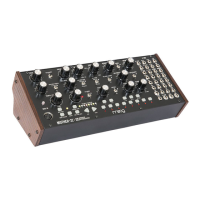10
VCO MODULATION
VCO MOD SOURCE
This switch is used to determine whether the LFO, EG or an external
modulation source is being sent to the VCO MOD AMOUNT control.
NOTE: If an external modulation source is patched into the VCO MOD input
patch point, and EG/VCO MOD is selected as your VCO MOD SOURCE, only the
external modulation signal will be applied to the VCO MOD AMOUNT control.
VCO MOD AMOUNT
This variable control determines how much modulation is applied to the
selected VCO Mod Destination. Low settings allow for subtle vibrato when
applied to Frequency, while medium settings allow for chorus-like effects
when applied to Pulse Width.
VCO MOD DESTINATION
This switch quickly determines whether your modulation source is applied to
the Frequency (pitch) of the Oscillator, or to the Pulse Width of the Pulse wave.
FREQUENCY
Subtle LFO pitch modulation of the Oscillator is useful for vibrato or adding
motion to a sound, while more extreme pitch modulation can be useful for
creating octave jumps or pitched drum sounds.
PULSE WIDTH
Slower and subtler use of LFO pulse width modulation can create large, chorus-like bass sounds, while faster
rates can be used to create sounds that your ear perceives as two oscillators beating against each other.
NOTE: It is possible to modulate the Pulse wave to 0% or 100% pulse width. This can result in sound
cutting in and out, which can be used in a variety of musical ways.

